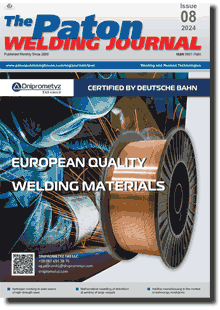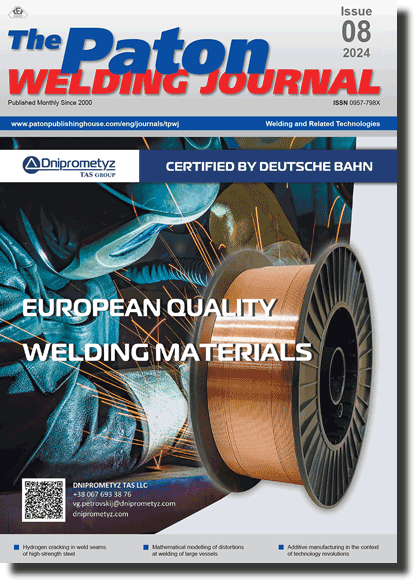| 2024 №08 (01) |
DOI of Article 10.37434/tpwj2024.08.02 |
2024 №08 (03) |

The Paton Welding Journal, 2024, #8, 10-17 pages
Mechanical properties of the reaction-diffusion bonding of the heat-resistant nickel-based alloy ChS70VI
V.E. Mazurak, M.O. Cherviakov, T.M. Kushnaryova, I.R. Volosatov
E.O. Paton Electric Welding Institute of the NASU. 11 Kazymyr Malevych Str., 03150, Kyiv, Ukraine. E-mail: cherviakov@paton.kiev.uaAbstract
The joint of the heat-resistant nickel-based alloy ChS70VI, obtained by the method of reaction-diffusion bonding during the formation of a weld by the melt of the heat-resistant nickel-based alloy with zirconium as a depressant is considered. The microstructures and concentration distribution of all chemical elements through the joint zone (with a gap width of ~20 μm and 50 μm) after the formation of the weld and subsequent heat treatment were analyzed. It is shown that the selected mode of heat treatment allows significantly reducing the amount of zirconium-rich eutectic phases (they are more easily melted, with a melting temperature of 960 °С), which increases the heat resistance of the joint. During heat treatment, the process of diffusion takes place, and the concentration of chemical elements in the weld is close to corresponding concentrations in the base alloy. Mechanical tests showed sufficiently high strength properties of the joint at temperatures up to 1100 °C. It was established that at the test temperature of 750°С, the strength of the joint is at the level of 95‒98 % of ultimate strength of the base alloy.
Keywords:heat-resistant nickel-based alloys, microstructure, mechanical properties, reaction-diffusion bonding, ChS70VI alloy, contact-reactive fusion, transient liquid phase bonding
Received: 01.11.2023
Received in revised form: 27.05.2024
Accepted: 19.08.2024
References
1. Kablov, E.N. (2001) Cast blades of gas turbine engines (Alloys, technologies, coatings). Moscow, MISIS [in Russian].2. Zhang, Y., Cheng, Y., He, N. et al. (2023) Microstructural characterization of TLP bonded joints of Mar-M247 superalloys with Ni-Cr-B interlayer. Mater. Charact., 198, 112766 https://doi.org/10.1016/j.matchar.2023.112766
3. Nesmikh, V.S., Yushchenko, K.A., Kushnaryova, T.M. (2005) Method of diffusion-reactive joining of metals and alloys. Pat. Ukraine 73308 [in Ukrainian].
4. Lashko, S.V., Lashko, N.F. (1988) Soldering of metals. Moscow, Mashinostroenie [in Russian].
5. Kvasnytskyi, V.V., Myalnitsa, G.F., Matvienko, M.V. et al. (2019) Investigation of interaction of Ni3Al-based alloy with interlayers of different alloying systems for TLP-bonding. The Paton Welding J., 8, 12-17. https://doi.org/10.15407/tpwj2019.08.03
6. Maksymova, S.V., Voronov, V.V., Kovalchuk, P.V. (2017) Brazing filler metal without boron and silicon for brazing of heat-resistant nickel alloy. The Paton Welding J., 8, 12-17. https://doi.org/10.15407/tpwj2017.08.02
7. (2020) DSTU ISO 6892-1:2019: Metallic materials. Tensile testing. Pt 1: Method of test at room temperature. Kyiv, SE UkrNDNTs [in Ukrainian].
8. (2021) DSTU ISO 6892-2:2020: Metallic materials. Tensile testing. Pt 2: Method of test at elevated temperature. Kyiv, SE UkrNDNTs [in Ukrainian].
9. Kishkin, S.T., Stroganov, G.B., Logunov, A.V. (1987) Casting high-temperature nickel-based alloys. Moscow, Mashinostroenie [in Russian].
10. Lashko, N.F., Zaslavskaya, L.V., Kozlova, M.N. et al. (1978) Physico-chemical phase analysis of steels and alloys. Moscow, Metallurgiya [in Russian].
11. (2001) State diagrams of binary metal systems: Refer. Book in 3 Vol. Ed. by N.P. Lyakishev. Moscow, Mashinostroenie [in Russian].
Suggested Citation
V.E. Mazurak, M.O. Cherviakov, T.M. Kushnaryova, I.R. Volosatov (2024) Mechanical properties of the reaction-diffusion bonding of the heat-resistant nickel-based alloy ChS70VI. The Paton Welding J., 08, 10-17.The cost of subscription/purchase order journals or individual articles
| Journal/Currency | Annual Set | 1 issue printed |
1 issue |
one article |
| TPWJ/USD | 384 $ | 32 $ | 26 $ | 13 $ |
| TPWJ/EUR | 348 € | 29 € | 24 € | 12 € |
| TPWJ/UAH | 7200 UAH | 600 UAH | 600 UAH | 280 UAH |
| AS/UAH | 1800 UAH | 300 UAH | 300 UAH | 150 UAH |
| AS/USD | 192 $ | 32 $ | 26 $ | 13 $ |
| AS/EUR | 180 € | 30 € | 25 € | 12 € |
| SEM/UAH | 1200 UAH | 300 UAH | 300 UAH | 150 UAH |
| SEM/USD | 128 $ | 32 $ | 26 $ | 13 $ |
| SEM/EUR | 120 € | 30 € | 25 € | 12 € |
| TDNK/UAH | 1200 UAH | 300 UAH | 300 UAH | 150 UAH |
| TDNK/USD | 128 $ | 32 $ | 26 $ | 13 $ |
| TDNK/EUR | 120 € | 30 € | 25 € | 15 € |
AS = «Automatic Welding» - 6 issues per year;
TPWJ = «PATON WELDING JOURNAL» - 12 issues per year;
SEM = «Electrometallurgy Today» - 4 issues per year;
TDNK = «Technical Diagnostics and Non-Destructive Testing» - 4 issues per year.


